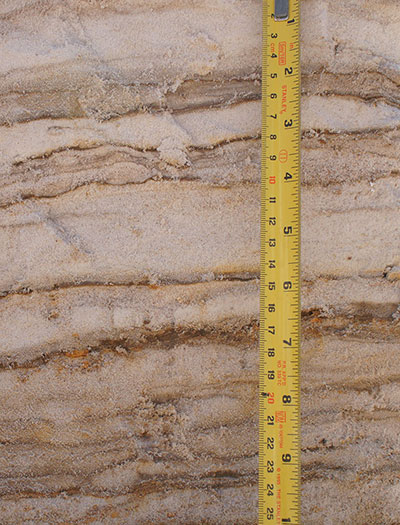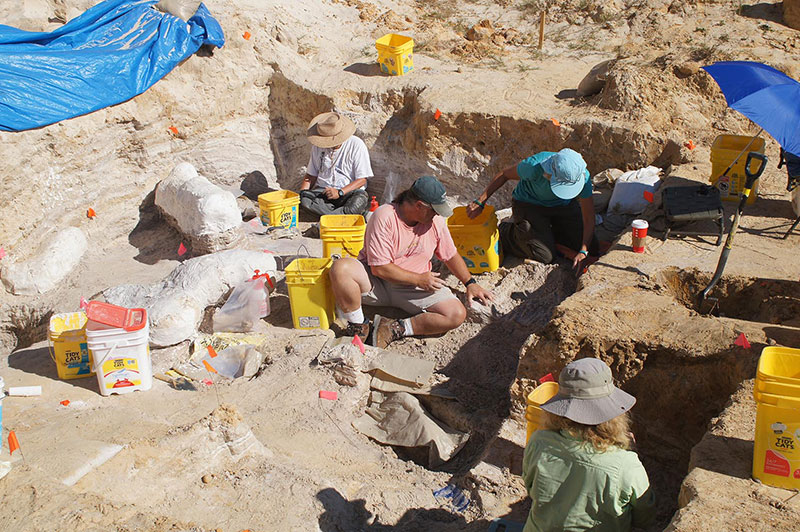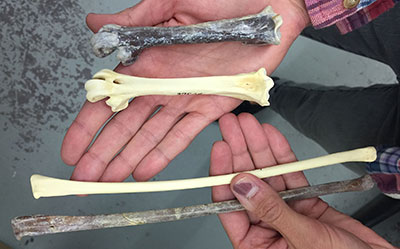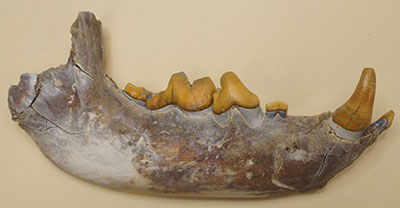Montbrook Site
University of Florida Vertebrate Fossil Locality LV070
Location
South of Williston, Levy County, Florida
Age
- Latest Miocene or earliest Pliocene epochs; late Hemphillian (Hemphillian 4 interval) land mammal age
- About 5.5 to 5 million years old (estimated)
Basis of Age
Vertebrate biochronology. A latest Hemphillian (Hh4) age is indicated by co-occurrence of the rhino Teleoceros, the gomphothere Rhynchotherium, and the canid Borophagus hilli.
Geology

At the Montbrook Site, reworded sediments from the Hawthorn Group (Scott, 1988) are overlain by a 5- to 7-foot-thick (~2 m) layer of eolian quartz sand of Holocene age. The Miocene at Montbrook consists of two units: 1) an orange to brownish red colored deposit of sandy clay; and 2) a sequence of alternating layers of sand and clay (Fig. 1). The upper portion of the sandy clay bed is sparsely fossiliferous, but the numbers of fossils increase in its lower half, greatly so in some places at the site. Within the sequence of sand and clay layers, those of sand are usually thicker and vary greatly in their composition, grain size, and sorting. Some consist of very well sorted, fine grains of quartz, while others are composed of a coarser, more poorly sorted mixture of quartz and phosphate grains that can range up into the gravel size category. Some of the sandy units are completely unconsolidated while others are more indurated. Spherical to sausage-shaped clay balls up to 4 cm in diameter are present in both the overlying sandy clay unit and the underlying sand beds.
From their composition, the most likely source for the Miocene sediments at the Montbrook Site was from erosion of older (early to middle Miocene), marine deposits of the Hawthorn Group. As evidence of this, a waterworn tooth of the early Miocene shark Carcharocles chubutensis was found in place at the Montbrook Site in early 2016. As the marine sediments of the Hawthorn Group are frequently rich in fossils of marine sharks, rays, and bony fish, fossils of marine species at Montbrook must be analyzed carefully to determine if they are reworked and not contemporaneous with the fossils of freshwater and land animals found at the site.
As of the end of the Spring 2021 excavation, in some places the fossil-bearing unit was over 9 ft thick (3 m) and its base had not yet been located, so this value is a minimum. Fossils have been recovered over an area exceeding 400 square meters, and the entire site is likely substantially larger than that value, but its lateral boundaries have not yet been established.
Depositional Environment
The deposit is most likely of fluvial origin, probably from a moderately large river close to the coastline.
Fossils

Excavation History and Methods
The Montbrook Site is located on private property and public access is not allowed. The landowner contacted the Florida Museum of Natural History (FLMNH) about fossils discovered on the property. Once they learned the scientific importance of the discovery, they allowed FLMNH staff and volunteers to conduct an extensive excavation between mid-November 2015 and mid-May 2016. This effort involved nearly 150 persons and 5,000 person-hours, resulting in the recovery of several thousand fossil specimens. A second field season began during the Fall of 2016 and ended in the middle of May, 2017. About 500 persons participated in this dig, the largest one we have ever held. Additional successful field seasons was held during the fall of 2017, the spring and fall of 2018, and the spring and fall of 2019. Only very limited excavations were possible during 2000 and the spring of 2021 due to restrictions related to the Covid-19 pandemic. Those interested in volunteering for an excavation should consult this website page.
The site was gridded into 1 X 1 meter squares and excavated with standard hand tools. About 20 tons of sediment from the fossil-bearing units was collected for screenwashing from 2015 to 2021. The most commonly found larger fossils are isolated spines, scales, teeth, and vertebrae of bony fish, the isolated shell elements from freshwater turtles belonging to the genera Trachemys (sliders), Macrochelys (alligator snapping turtles), and Apalone (softshell turtles), and isolated bones and osteoderms of Alligator. In the washed matrix, bones and teeth of fish are extremely abundant, but there are also fossils of salamanders, frogs, snakes, lizards, and small mammals such as rodents and shrews. More complete specimens, such as whole turtle shells and partial skeletons of land mammals are rare but occur most often in the alternating sand and clay layers. While relatively complete, such specimens at Montbrook display a high degree of post-burial compaction and crushing. They must be collected using plaster jackets and take a long time to prepare. The crushing is usually so extensive that the bones cannot be fully reconstructed, but just stabilized so that they can be stored and handled without further damage.

Discussion
Many of the Montbrook specimens remain unprepared and are not curated, but over 60,000 have received catalog numbers, making it one of largest vertebrate fossils sites in the state. The faunal list will probably change and expand as more collecting and curation proceed and detailed studies of the specimens occur. But it is already apparent that it will be very important locality from a scientific perspective. The site takes its name from the nearby, now defunct town of Montbrook.

Montbrook is the first late Hemphillian site found in north Florida. It is about 120 miles (200 km) north of the Palmetto Fauna, the state’s only other source of late Hemphillian fossils. But unlike that region, Montbrook is producing more complete specimens and contains the first significant terrestrial small vertebrate fauna of this age from Florida. The fossil fish in the Palmetto Fauna are predominately marine, while at Montbrook a much larger percentage of the fish lived in fresh water. Similarly, more of the bird fossils found at Montbrook are from taxa associated with freshwater or terrestrial habitats (Fig. 4), while all of the common birds in the Palmetto Fauna live along the coast and fed in the ocean. Despite over a century of collecting, the Palmetto Fauna contains less than half a dozen snake vertebra and no small rodents. There have already been several lower jaws of small rodents and numerous snake vertebrae found at Montbrook despite the fact that only a relatively small percentage of its sediment has been screenwashed and picked for microvertebrates. So Montbrook is providing the first direct evidence of its age about vertebrate life in a coastal river and adjacent habitats in the Southeastern United States.

Among the larger mammals at the Montbrook Site, the most commonly found taxon is gomphothere proboscideans. Footbones of both large- and small-sized individuals have been recovered, but at this time it uncertain if these differences in size represent two taxa (as is the case in the Palmetto Fauna), differences in ontogenetic stage (juveniles, subadults, full adults), differences in size between males and females, or some combination of these factors. At least two upper tusks, one adult and one subadult, with spiraled enamel bands characteristic of the upper tusk of members of the genus Rhynchotherium were collected at Montbrook during the spring of 2016. Two adult mandibles with m2-m3 were covered during the Spring 2018 field season. Additional gomphothere upper and lower jaws were found subsequent field seasons. The Mt. Eden fossil locality in southern California is only other place in the US that has produced a large sample of juvenile and subadult fossils of Rhynchotherium. Given their wide geographic separation, it will be interesting to compare the two samples once the Montbrook Site fossils have all been collected and prepared.
Mastodons (family Mammutidae) are abundant at many Pleistocene fossil sites in North American, including Florida. But they actually first appeared in North America during the middle Miocene, dispersing from Asia. But their fossil record during the middle and late Miocene is relatively poor, especially in contrast to the Pleistocene. While rarer than the Montbrook gomphothere, the site’s mastodons are represented by a minimum of three individuals, a young juvenile, an older juvenile, and a young adult. These appear to represent the same species of mastodon from the Palmetto Fauna.
The first scientific paper on Montbrook fossils was published in 2019 by David Steadman and Oona Takano. They described a new genus and species of large heron based on two specimens from the shoulder region, a coracoid and partial scapula. They were collected by two volunteers (Toni-Ann Benjamin and Sharon Shears) in adjacent meter-squares within one week of each other during the fall 2017 field season. So it is likely, but not certain, that the two specimens came from the same individual. The scientific name for this heron is Taphophoyx hodgei.
Sources
- Original Author(s): Richard C. Hulbert Jr.
- Original Completion Date: September 5, 2016
- Editor(s) Name(s): Richard C. Hulbert Jr.
- Last Updated On: January 2, 2022
This material is based upon work supported by the National Science Foundation under Grant Number CSBR 1203222, Jonathan Bloch, Principal Investigator. Any opinions, findings, and conclusions or recommendations expressed in this material are those of the author(s) and do not necessarily reflect the views of the National Science Foundation.
Copyright © Florida Museum of Natural History, University of Florida